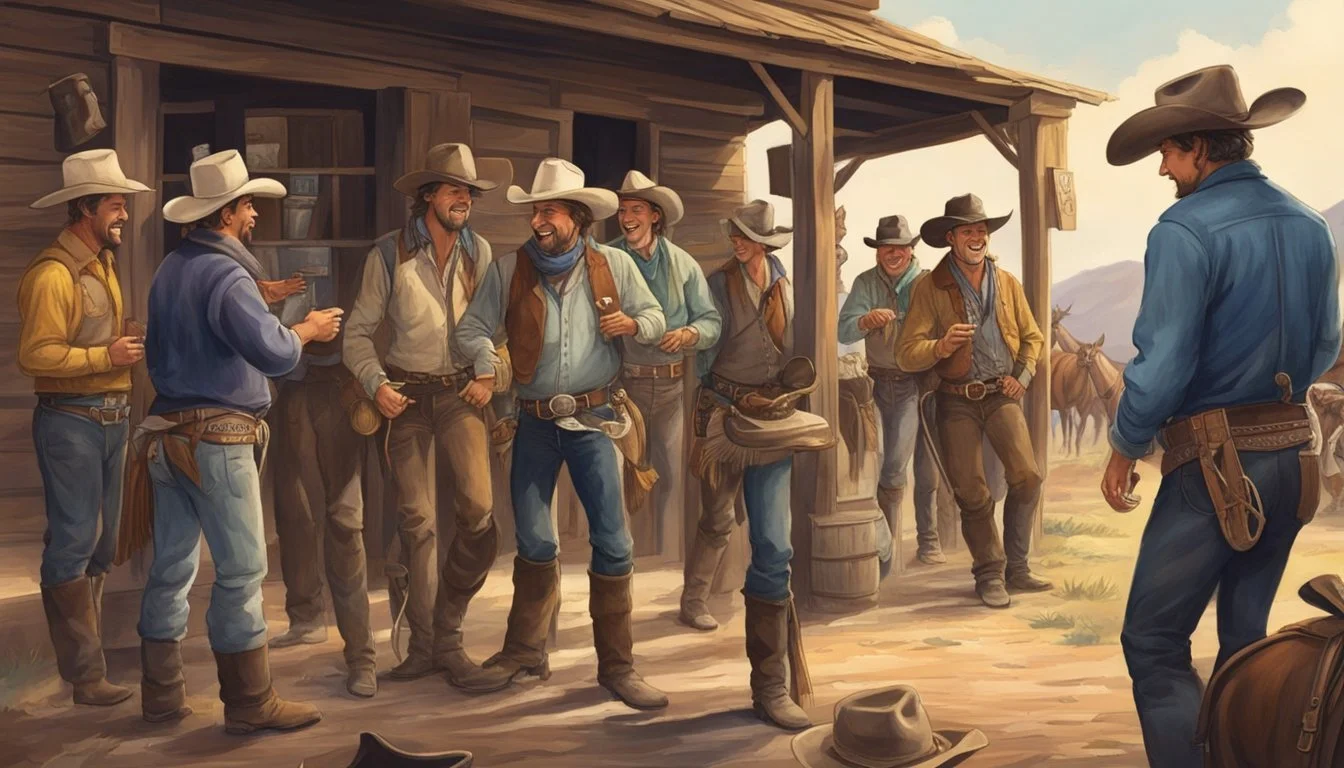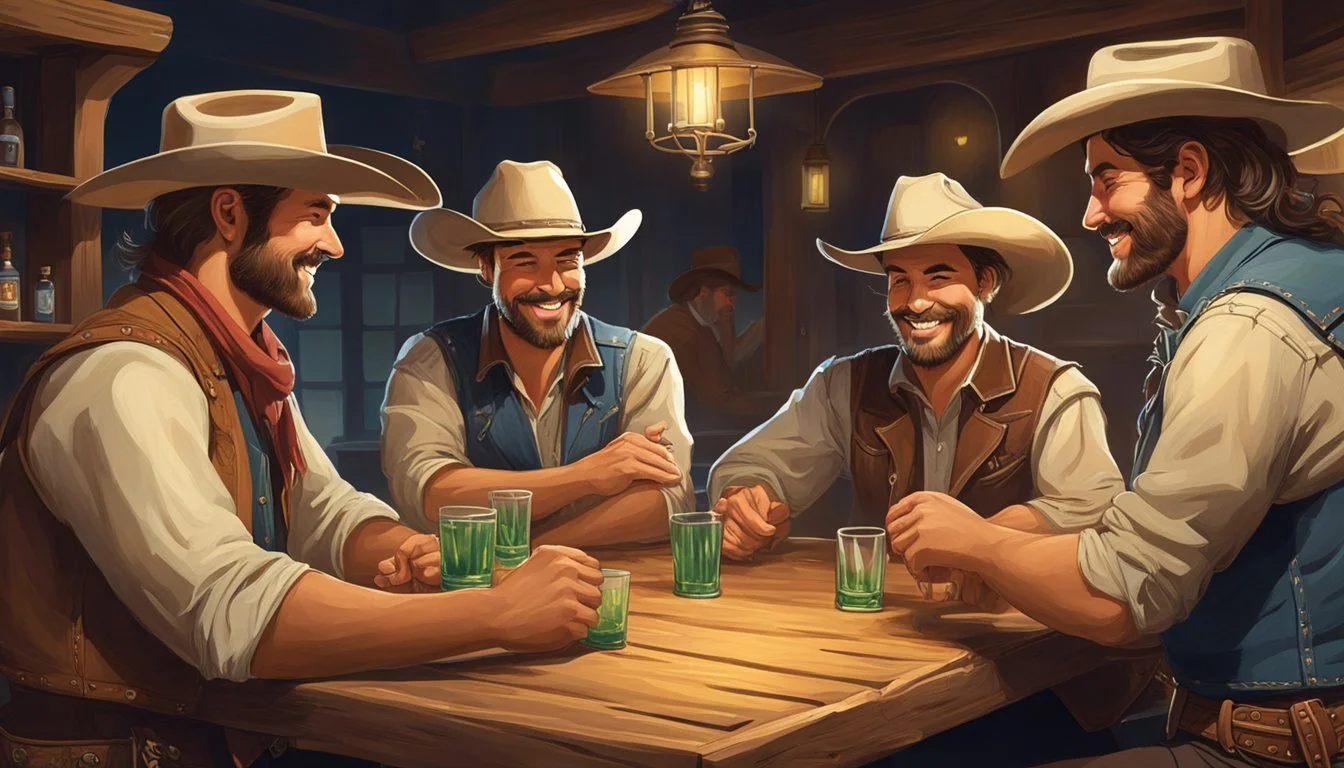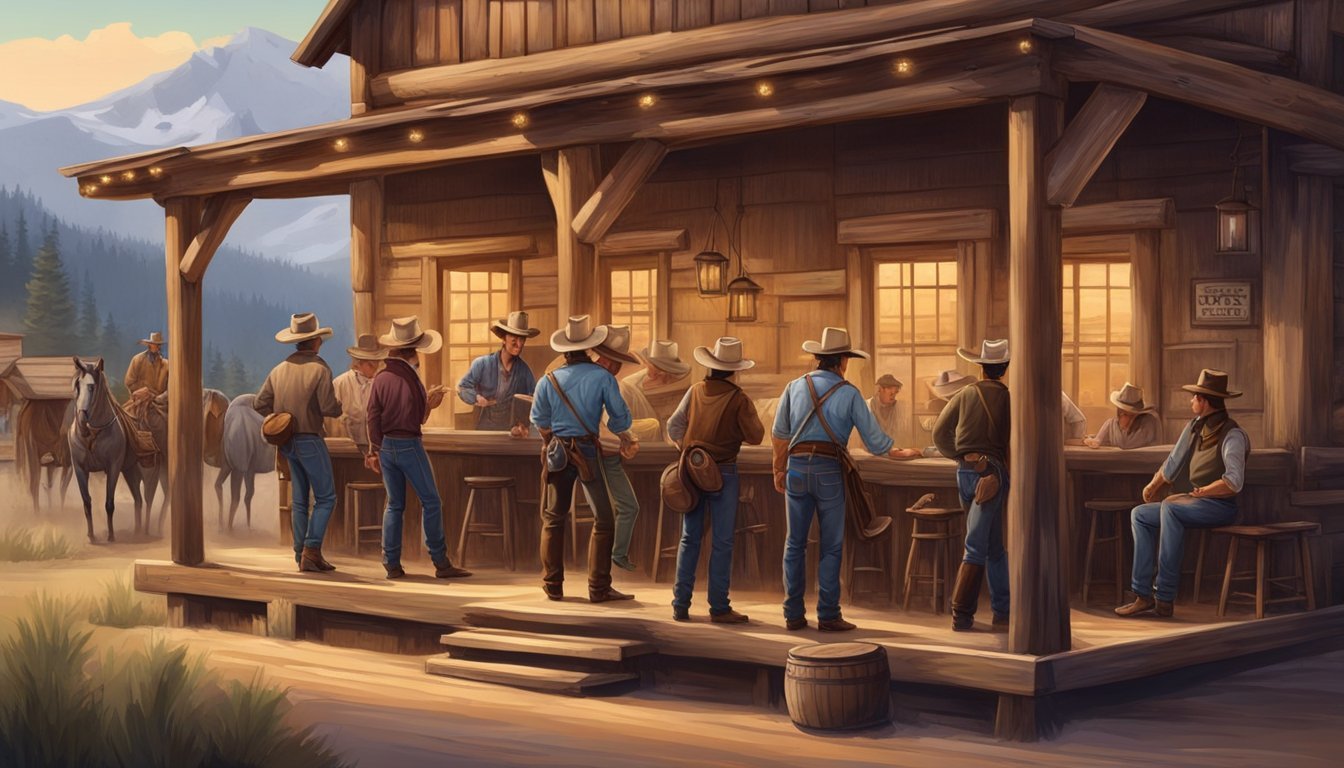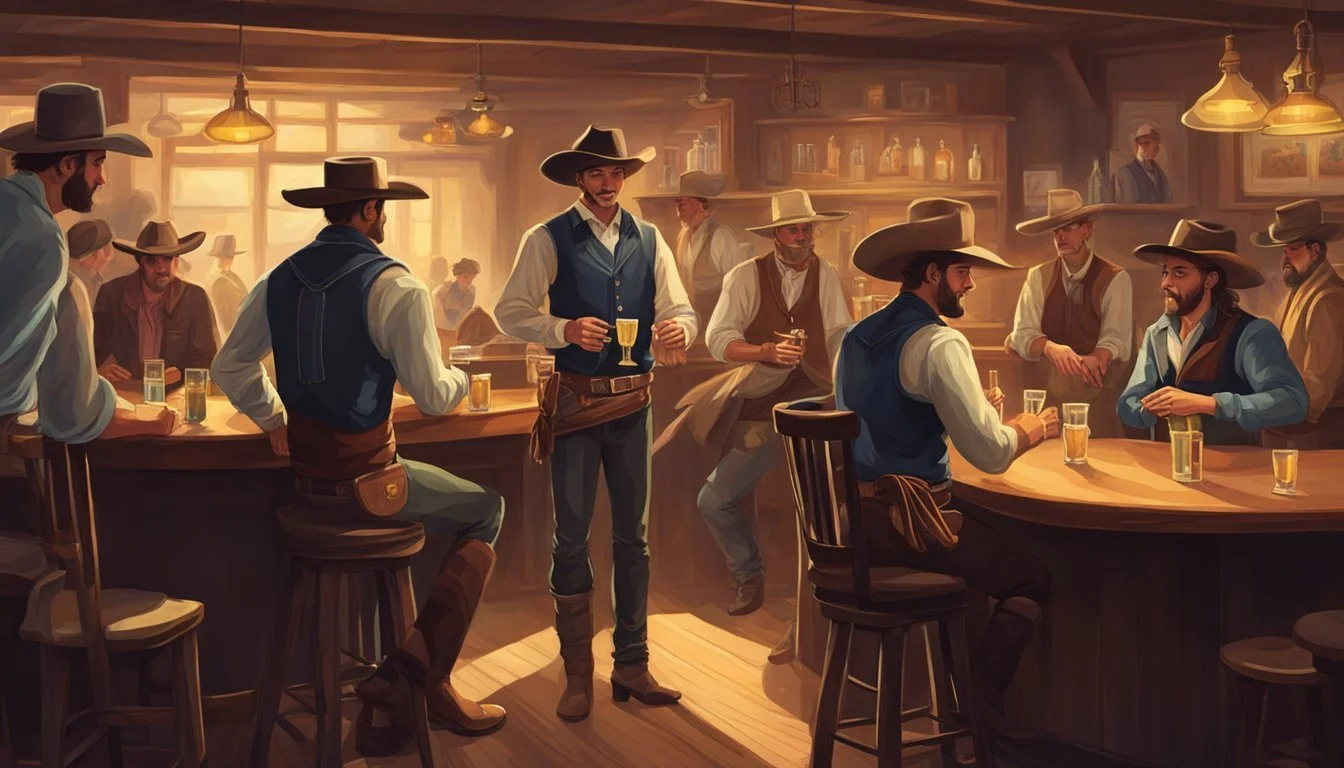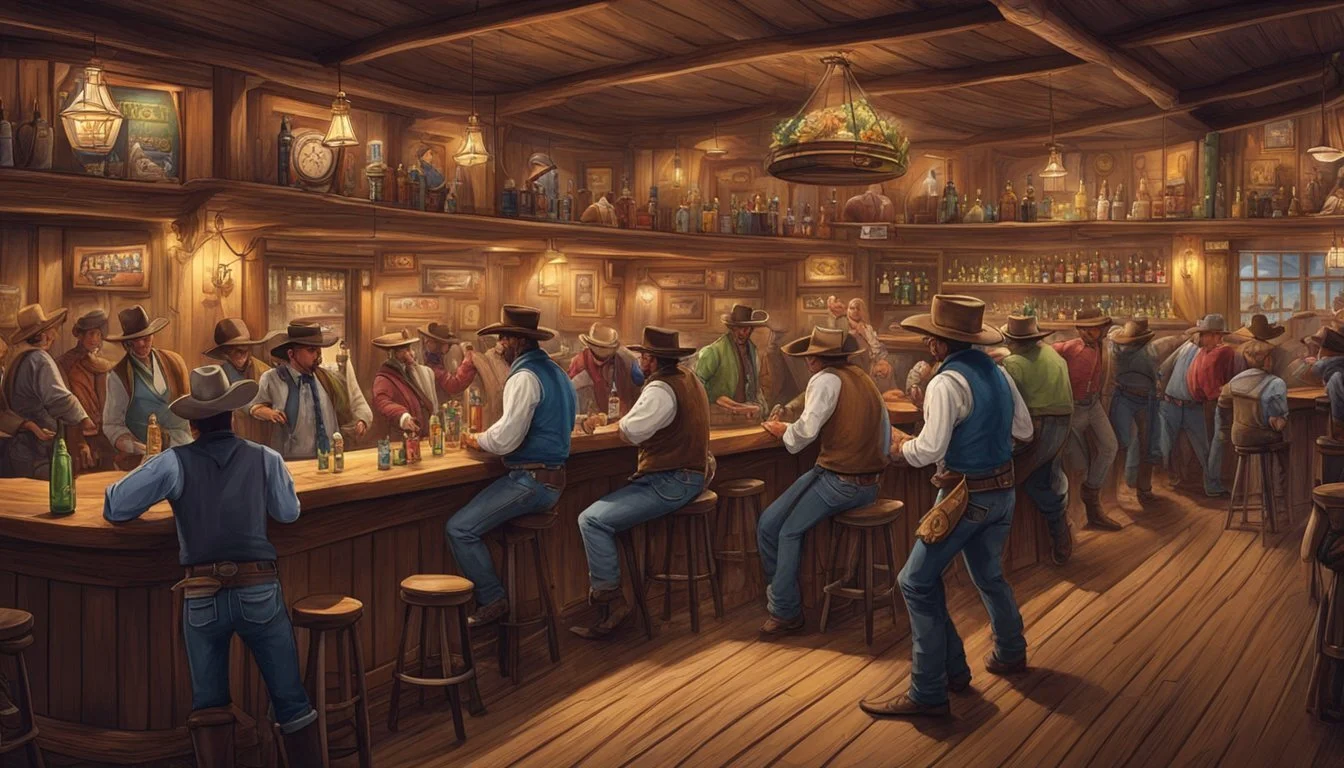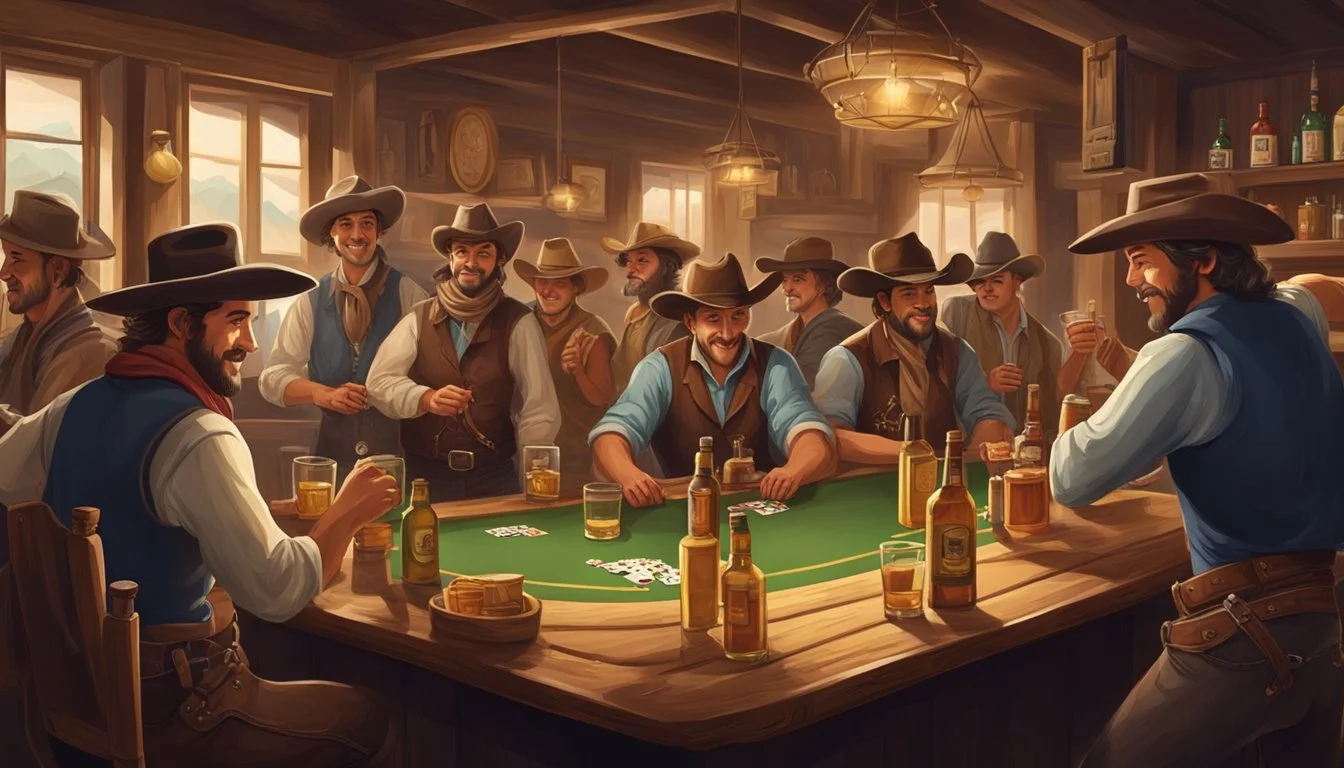The Role of the Saloon in Cowboy Social Life
A Central Hub for Western Camaraderie
In the nineteeth century American West, saloons emerged as pivotal social hubs for cowboys and other frontier denizens. These establishments, which often combined a bar, gambling hall, and space for social congregation, served as essential communal nexuses in towns where the rigors of westward expansion and the demands of cattle herding could foster a sense of isolation. Saloons offered a venue for cowboys to unwind, exchange news, and maintain a sense of community.
The social life of cowboys was intimately tied to these establishments. After long, solitary hours spent on the open range, saloons provided a welcoming environment for entertainment, companionship, and respite. Cowboys could share stories, engage in leisurely activities like card games or billiards, and establish enduring bonds over drinks. The saloon's role in cowboy culture was not limited to mere frivolity; it also acted as a critical information center where news and employment opportunities circulated.
Furthermore, these iconic venues reflected the economic and social dynamics of their time. Saloons often doubled as important economic centers where business transactions took place and where cowboys could spend their hard-earned wages. For a transient and often solitary population, the saloon was a beacon of civilization, a place to affirm one's place in the social order of the rapidly developing West.
Origins and Development
The saloon's evolution was a key feature of social life in the Wild West. It transitioned from a simple tent to a permanent structure that became central to many frontier towns.
From Tent to Structure
Early saloons were often makeshift tents or lean-tos that provided a basic drinking establishment for locals and travelers. These were temporary and mobile, catering to the needs of the shifting population. As frontier towns like Tombstone, Arizona, and Denver began to develop, the need for more permanent and structured business establishments became apparent. Saloons evolved and were constructed using lumber, with the iconic swinging batwing doors, a long bar, and a mirror backing the array of bottles. They became a hallmark of Wild West towns, offering social and recreational amenities beyond mere alcohol consumption.
Saloon Expansion During Gold Rush
The Gold Rush era significantly influenced saloon expansion. Prospectors flush with gold and miners looking to relax after hard labor would flock to saloons, which quickly became profitable businesses. Regions like Denver, which prospered during the Gold Rush, saw a boom in the number of saloons. It was common for a saloon to be one of the first businesses established in a boomtown, signifying the beginning of community development. Saloons provided a space for miners to spend their earnings, socialize, and network, playing a crucial role in shaping the burgeoning community structure.
Economic Impact
The saloon was a central economic force in the cowboy culture, acting both as a standalone business and as a catalyst for local trade and economic activities.
Saloon as Business
Saloons emerged as pivotal business ventures on the frontier. They began as simple tents and gradually evolved into more permanent structures with elaborate furnishings that included polished bars and gaming tables. It wasn't uncommon for a saloon to start from a tent structure during a gold rush and, as money flowed into the town, be upgraded to a wooden or even brick building. The profitability of a saloon was directly tied to its ability to attract patrons, often through a combination of alcohol, gambling, and social events.
Primary Revenue Streams:
Alcohol sales
Gambling fees
Service offerings (e.g., food, lodgings)
Role in Local Trade and Economy
Saloons served as central hubs in local trade networks, facilitating exchange not only of money but also of information that could affect trade and business. They often were among the first establishments to appear in a boomtown, signaling the start of economic development. Trade in goods, from basic necessities to luxury items, often centered around the saloon, which could be considered the versatile heartbeat of commerce in many a western town.
Economic Contributions:
Increased cash flow in the local economy
Served as informal job centers and places for trade discussions
Acting as early banks for gold or money savings and transactions
Social Dynamics
Saloons served as pivotal social hubs in the Old West, where various social classes converged and where both informal and formal social codes were established and reinforced.
Gathering Place for Different Social Classes
Saloons were venues where cowboys, miners, and settlers of different backgrounds mingled freely. Despite the class disparities of the era, saloons acted as a leveling ground where the rich and poor could interact. For instance, a wealthy cattle baron might be found having a drink next to a hired hand.
Cowboys: The backbone of the cattle industry, often found relaxation and camaraderie within saloon walls after long, arduous trails.
Women: While less common, women did frequent saloons, particularly those who worked there; their presence was a draw for many patrons.
It was not unusual to see a diverse intersection of society, including immigrants and native-born Americans, sharing stories and conduct that crossed socio-economic lines.
Influence on Social Norms and Order
Saloons often functioned under an unspoken code where certain behaviors were expected and others frowned upon. They were places where social norms and order were negotiated daily.
Law: Despite being places of business, saloons could both challenge and uphold the law. Local sheriffs and lawmen were regulars, negotiating peace or enforcing order as situations demanded.
Violence: Fights and brawls were not uncommon, due to the mix of alcohol, gambling, and other high-stakes activities.
Church: The establishment of a saloon often stood in philosophical opposition to the church, with both competing as social centers and moral compasses of frontier towns.
The role of the saloon as a central social institution was complex, with impacts on the evolving social order of the American West.
Entertainment and Leisure
In the vibrant social hubs that were the saloons of the Old West, entertainment and leisure activities centered on live music, dancing, and a variety of games. These offerings were the lifeblood of saloon culture, providing cowboys and other patrons a means to unwind after long, arduous days.
Live Music and Dancing
Saloons often echoed with the sounds of live music, providing a backdrop for the lively and sometimes rough-and-tumble dancing. It was common for a pianist or a small band to play tunes that became the soundtrack of the era. Patrons participated in dances such as the waltz and the square dance, which were staples of saloon entertainment. Music and dance provided an escape and a platform for social interaction among cowboys, travelers, and locals.
Games and Gambling
Gambling was an integral part of the saloon experience. Most establishments featured various gambling games that included:
Poker: A favorite among patrons, poker was a mainstay of the saloon's gaming offerings.
Faro: Less known today but equally popular at the time, faro tables often occupied a prominent space.
Other Card Games: Beyond poker and faro, a host of other card games were regularly played.
These games often took place in the backdrop of a designated gambling hall within the saloon, where bets were placed and fortunes could be made or lost in the course of an evening. The gambling hall became a theater of human drama, where the stakes were high and the outcomes were as unpredictable as the character of the Old West itself.
Cultural Significance
The saloon serves as a pivotal cornerstone in the understanding of the Old West, intricately portrayed in literature and film and emblematic of the frontier spirit.
The Saloon in Literature and Film
In literature and film, the Western saloon is often depicted as a bustling epicenter of activity for cowboys, outlaws, and gamblers. Hollywood has cemented the image of the saloon with its swinging doors and raucous piano music as a staple setting in Western movies. Saloon girls serve as both characters and symbols of the complicated gender dynamics of the time, while high-stakes poker games and gunfights over issues of honor and rivalry furnish the saloon with a sense of suspense and drama.
In Literature: Western novels frequently describe the saloon as a microcosm of society, where tales of heroism and villainy are played out.
In Film: Classics like "High Noon" and "Tombstone" have immortalized the saloon as a place where the tensions of the Old West come to a head.
Saloon as a Symbol of the Old West
The Western saloon is a powerful symbol that evokes the lawlessness and the rugged individualism of the Old West. They mirrored the aspirations and adversities of those who sought new opportunities in these frontier lands.
Lawlessness and Individualism: The saloon encapsulated the essence of the untamed frontier, where individuals came to escape the constraints of society.
Social Hub: Functioning as more than just a place for drinking, it was the nucleus of social life, where information was exchanged, deals were struck, and communities were formed.
Everyday Functions
In the fabric of cowboy social life, saloons fulfilled essential roles beyond mere drinking establishments, offering a range of services and refreshments that catered to the needs of their clientele.
Saloon Services
Saloons operated as multifaceted spaces within cowboy society, with bartenders providing not just beverages but also a variety of other amenities. Customers could expect the following services:
Drinking: A primary function, with a focus on alcohol such as beer and whiskey.
Socializing: Acting as meeting hubs for the community.
Gaming: Many saloons housed tables for cards and gambling activities.
News Exchange: They served as information centers where patrons could catch up on news and gossip.
Mail Services: Some acted as makeshift post offices.
Items such as spittoons and chewing tobacco were commonplace, the former being an essential fixture catered to the prevalent habit of tobacco chewing, while aiding in maintaining a modicum of cleanliness.
Foods and Beverages Offered
The culinary offerings in saloons were straightforward, catering to customers looking for sustenance. Common items found on the menu included:
Food Item Description Stews Often a hearty option served with bread Beans A staple in the cowboy diet Salted Meats Provided sustenance for long days
Regarding beverages, saloons provided a range of options:
Alcoholic Options: Predominantly whiskey and beer.
Non-Alcoholic Options: Options like tea were available for non-drinkers.
The barkeep ensured a consistent supply of both food and drink, serving as a central figure in saloon operations and patron experience.
Interactive Hub
The saloon in the Old West served as a pivotal interactive hub, assimilating diverse roles to facilitate information exchange and social relations among cowboys, locals, and travelers.
Center for News and Communication
Saloons were commonly the first place locals and travelers alike would visit to catch up on the latest news. They functioned as informal news centers, where word of mouth played a crucial role in disseminating information. Here, people shared stories, conversations flourished, and messengers often relayed updates on regional and national events.
Role in News Dissemination
First point of contact for new arrivals to receive updates
Bulletin boards for posting notices and news
Conversation and Rumor Exchange
Locals and travelers exchanged stories and rumors
Barkeepers and patrons engaged in discussions about local happenings
Meetings and Socialization
The saloon was a social nexus where individuals converged for camaraderie and relaxation. Meetings and socialization were integral, with cowboys often engaging in games of cards or sharing drinks after a long day. This atmosphere provided a rare opportunity for socialization far from the isolation of the range or long cattle drives.
Facilitating Social Bonds
Regulars established enduring friendships
Newcomers found companions and integrated into the community
Entertainment and Leisure Activities
Games and music served as common pastimes
Spontaneous gatherings and celebrations occurred regularly
Regulation and Prohibition
As the American West evolved, so too did the regulatory environment surrounding saloons. Increased law enforcement and societal pressures paved the road to prohibition, altering the social landscape cowboys once knew.
Law Enforcement
Law enforcement in the Western frontier began escalating its presence as towns grew and sought more structure. Sheriffs and marshals were tasked with curbing the violence and rowdiness associated with saloons. This often involved enforcing local ordinances that could range from prohibiting carrying firearms in the saloon to setting curfews.
Violence Reduction: Efforts were made to reduce saloon-related shootings and brawls.
Regulation Compliance: Saloons were compelled to follow stricter licensing regulations.
The Path to Prohibition
Prohibition was the culmination of escalating regulations and a growing temperance movement aimed at eliminating the saloon's perceived negative influence on society.
Early Regulations: Restrictions on gambling and alcohol consumption began to reshape the social functions of the saloon.
Temperance Advocacy: Temperance groups campaigned vigorously against the saloons, leading to the 18th Amendment.
1919: Prohibition Act (Volstead Act) was passed, leading to nationwide prohibition.
1920s: At this peak, prohibition drastically lowered the prevalence of saloons.
These efforts, though initially met with resistance, ultimately led to the permanent closure of many establishments as the Prohibition era took hold across the United States.
Legendary Establishments and Figures
In the tapestry of the Old West, saloons were more than mere drinking spots; they were social hubs where legends were made. This section uncovers the stories behind famous saloons and the personas that carved their names into Western lore.
Famous Saloons and Their Impact
Colorado and Nevada were epicenters for some of the most well-known saloons. For instance, Virginia City, Nevada, boasted establishments frequented by miners hoping to strike rich during the Comstock Lode silver rush. It was not just a place to drink but also a community center for the bustling mining town.
White Elephant Saloon in Fort Worth, Texas, became a landmark in its own right. The White Elephant attracted a clientele who were a blend of cattlemen, outlaws, and lawmen, often blurring the lines between respectability and notoriety.
In Arizona, saloons served as pivotal gathering spaces in the arid deserts, offering respite for weary travelers and a spot for locals to congregate and share news.
Location Saloon Name Historical Significance Fort Worth, TX White Elephant A nexus for cattlemen, frequented by figures like Luke Short. Nevada Virginia City Community hub during the mining boom, playing host to prospectors. Arizona Various Saloons Crucial rest spots in frontier towns, integral to Arizona's social life.
Notable Personalities
Saloons also served as a backdrop to the lives of some of the Old West's most storied individuals. Wyatt Earp and Wild Bill Hickok are two such figures whose presence in these establishments added to their legend.
Wyatt Earp, infamous for his role in the Gunfight at the O.K. Corral, was known to have associations with several saloons across the West, including in Arizona where his lawman career became legendary.
Wild Bill Hickok, on the other hand, was a skilled lawman and gunfighter whose exploits were often associated with the saloon settings of Kansas and South Dakota.
Their stories are woven into the fabric of saloon mythology, elevating their status from mere men to legends of the American frontier.
Personality Known For Saloon Connection Wyatt Earp Lawman, Gunfight at the O.K. Corral Associated with saloons throughout Arizona. Wild Bill Hickok Gunfighter, Lawman Frequented saloons in Kansas and South Dakota.
Transformation and Decline
The role and presence of saloons in society shifted dramatically with industrialization and the eventual introduction of Prohibition.
Effects of Industrialization
Industrialization brought about fundamental changes in the business models and societal norms that impacted the function of Old West saloons. As transportation and communication improved, businesses expanded and centralized, leading to a decline in the smaller, local establishments that could not compete. The rise of more regulated and homogeneous entertainment venues started to eclipse the unique and often raucous nature of saloons. Businessmen seeking profit were at the forefront of this transformation, investing in more family-friendly establishments that could appeal to a broader section of society.
End of an Era
Prohibition in the 1920s marked the official end of the saloon era. This nationwide constitutional ban on the production, importation, transportation, and sale of alcoholic beverages severed the core offering of saloons. Many saloon owners were forced to close their doors or shift to new business ventures. While illegal speakeasies did briefly rise in prominence, these too did not hold the same place in society as the old west saloon, which by then had been consigned to the history books, symbolizing the closing of a significant chapter in the social life of cowboys and American frontier culture.



